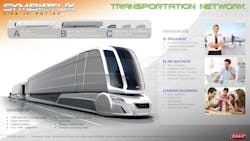A recent report by Volpe, the DOT’s the National Transportation Systems Center, identifies emerging technologies that may have significant impacts on U.S. and global transportation systems within three to five years. And most of these will find their way into—or become a replacement for—trucks and trucking.
“Advances in just the past decade have dramatically changed the way Americans travel and deliver goods, and the pace of change is something we cannot dictate,” writes U.S. DOT Assistant Secretary for Research and Technology Gregory Winfree in the report’s foreword. “This is why we must be proactive and look to new technologies that have clear applications for transportation. However, new technologies can also introduce new risks, and we must anticipate the full range of potential impacts.”
The resource, 2015 OST-R Transportation Technology Scan: A Look Ahead, identifies 11 technological advances and innovative concepts—along with their associated benefits, challenges, and risks—that could fundamentally alter the transportation landscape.
The report notes that there are large areas of overlap among the technologies, and many of them are “intimately interrelated.”
“Ultimately, we can expect the unexpected: these technologies will evolve and interact in ways we cannot imagine today,” the report says. “Further, the role of basic science research remains a wild card, as breakthroughs in fundamental understanding could spur further advances that cut across many of these areas of innovation.”
So what’s in it for trucking? Here are eight of the technologies to watch:
The Internet of Things: IoT means connected vehicles and smart infrastructure: e.g., bridge sensors that detect icing and alert approaching vehicles. This also leads to the integration of smart transportation (e.g., traffic management and parking) within broader systems-of-systems.
For drivers, IoT means wearable sensors combining GPS data with physiological data. Potential benefits include monitoring alertness and physiological conditions, particularly regarding fatigue detection.
Advanced analytics and machine learning: “Big data analysis has the potential to spur productivity, growth, and innovation, as long as the right policies and enablers are in place.” (Emphasis added.)
Thinking positively (and saving Big Brother worries for another time), this means real-time traffic analysis across much wider systems, and much better traffic forecasts and predictive routing. On the vehicle itself, sensors already allow system operators to remotely monitor rolling stock, including performance, location, video cameras, and fault warnings. These systems can enable a risk-based approach to preventive maintenance. In addition, predictive analytics have the potential to improve defect investigation.
“On the other hand, widespread adoption of fully automated vehicles, especially as privately owned passenger cars, presents significant uncertainty,” the report says.
Unmanned aircraft systems (UAS): As far as the supply chain goes, look no further than the highly publicized effort by Amazon to develop a parcel delivery drone. “Similar applications could emerge to supplement existing ground transportation services by providing first- and last-mile freight and package delivery,” according to Volpe.
On-demand ride services (transportation network companies): Taxi alternatives get the buzz, but the same technology is increasingly being used by companies looking for a piece of the logistics pie.
“Freight brokerage firms are using these platforms to match shipments with drivers,” the report points out. “With over 20 billion miles per year driven by empty trucks in the United States, matching shipments to drivers could dramatically improve efficiency.”
Wireless power transfer: Think of smartphone charging mats, only big enough for a bus or a truck. Look for this technology first at ports, which are heavily trafficked by vehicles largely constrained to on-site use. The technology would grow with wider adoption of electric delivery vehicles in urban areas. Readily available in-roadway wireless charging would have the additional benefit of allowing vehicles to use smaller batteries and increase payload.
Additive manufacturing (3D printing): While 3D printers are increasingly used in vehicle prototyping and creating replacement parts, the real question for trucking is what will the technology mean for freight?
“Supply chains and distribution networks for certain types of goods may be significantly disrupted,” the report says. “3D printing may allow for more localized production and decentralized manufacturing. Deliveries of finished goods may fall, while shipments of raw materials might rise. This could mean reduced infrastructure requirements, as some of the items currently manufactured overseas shift to domestic production facilities. Overall, wear and tear on the infrastructure could be reduced, but that effect might be partially offset by more local deliveries with smaller vehicles.”
What’ll it mean for freight? The possibilities are even more numerous than the practical challenges of making this technology work. But we’ll see.
In the meantime, you’ve got to keep up.








